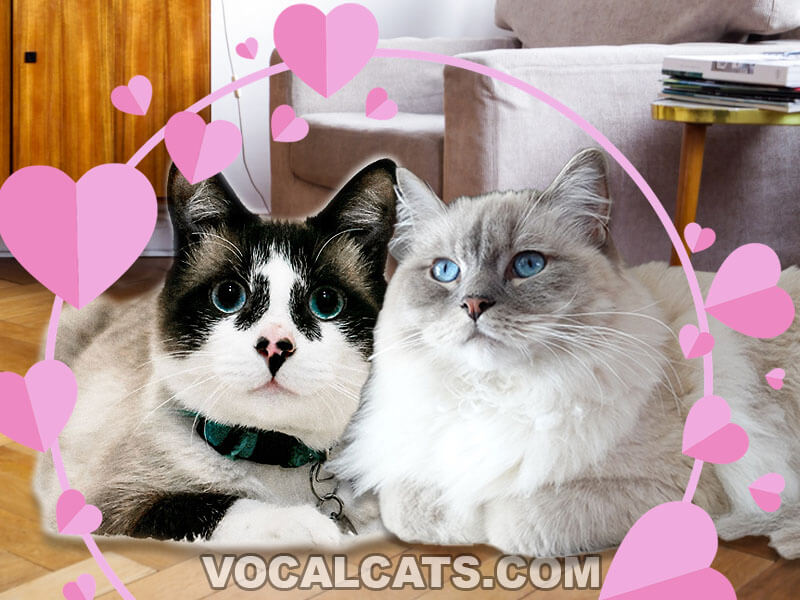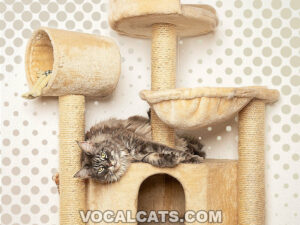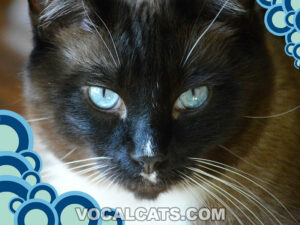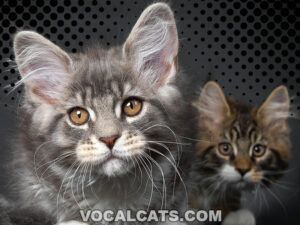Interested in adding a new kitty to your home? Then, let me introduce you to the bewitching Ragdoll Snowshoe Cat that has sparkling blue eyes and a beautiful, silky colorpoint coat.
The Ragdoll Snowshoe Cat is a fairly new mixed breed that combines the unique physical and temperamental qualities of the Ragdoll and the Snowshoe cats.
The Ragdoll, due to its popularity, has often been mixed with other cat breeds, like the Siamese to produce the Siamese Ragdoll Cat. These mixed-breed cats are believed to be healthier than their parent breeds due to the lack of inbreeding linked to purebred cats. So, without further ado, let us take a look at the Ragdoll Snowshoe Cat.
Contents
- Ragdoll Snowshoe Cat: Breed overview
- What is a Snowshoe Ragdoll Cat?
- Snowshoe Ragdoll parent breeds
- Snowshoe cat history
- How do I know if my cat is a Snowshoe?
- Are Snowshoe Cats rare?
- Ragdoll history
- What two breeds make a Ragdoll cat?
- Are Snowshoe Cats and Ragdolls the same?
- Snowshoe Cat vs Ragdoll
- Are Ragdoll Snowshoe Cats recognized by cat registries?
- Are Snowshoe Ragdoll Mix rare?
- Ragdoll Snowshoe mix Cat physical appearance
- Ragdoll Snowshoe Cat size, height, and weight
- Various Snowshoe Cat Ragdoll coat colors and types
- Ragdoll Snowshoe mix personality and temperament
- Do Snowshoe Ragdoll Cats make great family pets?
- Snowshoe Ragdoll training
- Ragdoll Snowshoe Cat exercise requirement
- Snowshoe Ragdoll Cat grooming and cleaning
- Are Snowshoe Ragdoll Cats hypoallergenic?
- Do Ragdoll Snowshoe Cats shed?
- Snowshoe Ragdoll mix food and diet
- Ragdoll Snowshoe Cat common health issues
- Is my cat a Snowshoe?
- How long do Snowshoe Ragdoll cats live?
- Snowshoe Ragdoll mix breeders
- Snowshoe Ragdoll kittens
- Ragdoll Snowshoe Cat price
- Places to find Snowshoe Ragdoll kittens for sale
- Finding a healthy Snowshoe Ragdoll Cat for sale
- Mixed breeds similar to Ragdoll Snowshoe Cat
- Ragdoll Snowshoe Cat: Pros and Cons
- Is the Snowshoe Ragdoll Cat right for me?
Ragdoll Snowshoe Cat: Breed overview
| Other names | Snowshoe Ragdoll cat |
| Size | Medium – Large |
| Weight | 8 – 20 pounds |
| Height | 8- 13 inches |
| Coat Colors | Seal, Cream, Blue, Red, Lilac, Chocolate |
| Child Friendliness | High |
| Feline Friendliness | High |
| Training Difficulty | Moderate |
| Grooming Upkeep | Moderate |
| Exercise Needs | Moderate |
| Health | High |
| Lifespan | 12 – 18 years |
| Kitty Costs | $800 – $2,000 |
What is a Snowshoe Ragdoll Cat?
The Snowshoe Ragdoll Cat is a cross between two colorpointed cats – the Ragdoll and the Snowshoe Cats.
Snowshoe Ragdoll parent breeds
The Snowshoe Ragdoll is a hybrid cat, so it is quite unpredictable to know how they will look and behave when they mature. It is by learning about each individual parent that we will know how they will turn out.
The Ragdoll is a blue-eyed cat with distinctive colorpoint patterns on the head, ears, face, legs, and tail. They are well known for their dog-like personality and tendency to go limp when picked up.
The Snowshoe, on the other hand, is also a breed with distinct colorpoint markings with the distinction of having white-colored paws. They are blue-eyed as well and are admired for their sociable and talkative nature.
Snowshoe cat history
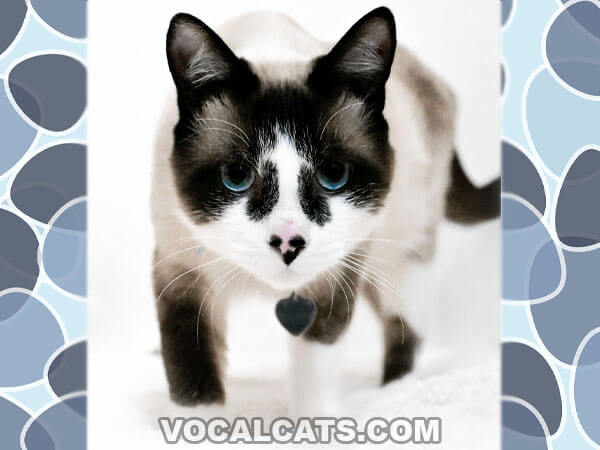
The Snowshoe Cat was developed by Dorothy Hinds-Daugherty in the early 1960s in Philadelphia by crossing Siamese cats with unique white boot markings with the American Shorthair Cat with tuxedo markings.
The result after several crosses was a cat with white colorpoint markings on the paws and a white inverted ‘V’ marking on the face which she named the “Snowshoe.”
After several years, Hinds-Daugherty terminated the breeding program but was continued by Vikki Olander.
The latter succeeded in obtaining an experimental breed status from the Cat Fanciers Federation and the American Cat Association in 1974.
Several Snowshoe enthusiasts furthered the breed’s program in the following years and were able to obtain a champion breed status from several cat registries.
However, the Snowshoe has yet to be fully recognized by the Cat Fanciers Association (CFA) since the breed has not yet met the requirements of the association.
How do I know if my cat is a Snowshoe?
The Snowshoe Cat is mainly characterized by its white paws or white boot markings on each leg. Most will also have an inverted white ‘V’ marking on the face but some may not exhibit this feature.
Another characteristic of this breed is their beautiful blue eyes which come from their Siamese heritage.
Are Snowshoe Cats rare?
Yes, the Snowshoe Cat is quite rare because of the specific coat markings it should have. The colorpoint markings on the paws and face depend on certain recessive genes and other factors.
The white boots are a result of the piebald gene. Producing a Snowshoe Cat with just the right amount of white in the paws can be difficult because some of the white markings can overextend on the legs.
The gene that affects the inverted ‘V’ pattern is also hard to control. Some Snowshoe offspring would have two dominant pairings of this gene which results in a white marking that is larger than the ideal size.
Ragdoll history
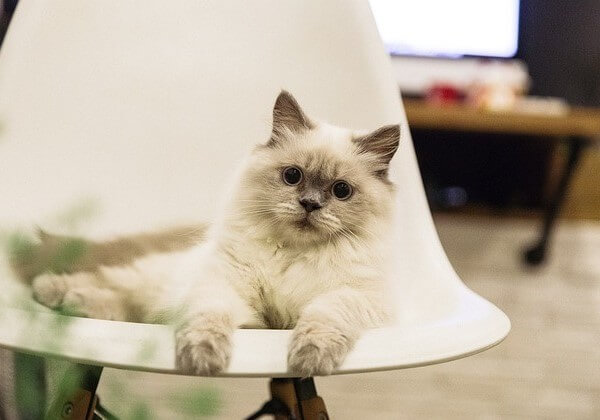
The Ragdoll was developed right about the same time as the Snowshoe Cat. It was first bred by Ann Baker in California by crossing a white Persian-type female cat named Josephine with several Birman-type cats.
The result was a cat with particular colorpoint markings on the coat with a temperament that is calm and a tendency to go limp when carried, which eventually led Baker to name the cat, Ragdoll.
Baker later created her own registry called the International Ragdoll Cat Association (IRCA) and imposed a strict standard for the breed and barred it from getting registered in any cat associations.
In later years, Ragdoll enthusiasts formed their own groups and separated from Baker, which led the Ragdoll to be accepted in major cat registries.
CHECK OUT: White Ragdoll Cat (Complete Guide)
What two breeds make a Ragdoll cat?
The first Ragdoll produced by Ann Baker is believed to be a cross between a Persian-type queen cat with a Birman or Birman-type male.
Are Snowshoe Cats and Ragdolls the same?
No, the Snowshoe and the Ragdoll are two completely separate breeds of cats. What makes them similar is the colorpoint markings on their coat.
In fact, the Snowshoe would have the same coat markings as a Bicolor Ragdoll with white paws, white inverted ‘V’ markings on the muzzle, and a white chest. Both have also the characteristic blue eyes with the difference being in the length of their coat.
You may be interested in: Blue Eyed White Ragdoll (Complete Guide)
Snowshoe Cat vs Ragdoll
The main difference between Snowshoe Cat and Ragdoll is that Snowshoe Cat has short to medium length hair while Ragdoll has medium to long length of hair.
Are Ragdoll Snowshoe Cats recognized by cat registries?
No, the Ragdoll Snowshoe Cat is not recognized by cat registries because they are a mixed breed with no standard physical characteristics.
Are Snowshoe Ragdoll Mix rare?
Yes, Snowshoe Ragdoll Mix can be considered rare since the number of Snowshoe breeders is very limited.
Ragdoll Snowshoe mix Cat physical appearance
It is hard to predict what a Ragdoll Snowshoe mix Cat would look like since it could take on the physical features of either parent.
The head shape could be broad with ears that are set wide apart just like the Ragdoll, or it could be triangular in shape with ears set closer to the head similar to the Snowshoe.
Both the Snowshoe and the Ragdoll have a long and muscular body structure, so the Ragdoll Snowshoe Mix Cat would display the same characteristic.
Another striking feature of the Ragdoll Snowshoe Mix is their sparkling blue eyes since most colorpointed cats have this physical characteristic.
Ragdoll Snowshoe Cat size, height, and weight
Ragdolls are larger and heavier than the Snowshoe cat having a weight range of 8 to 20 pounds compared to the Snowshoe which only weighs between 7 to 14 pounds.
Ragdoll Snowshoe Mix cats that inherited the larger size of the Ragdoll may take up to 4 years to fully mature and reach their full grown size while a smaller Ragdoll Snowshoe Mix may take only around 2 years to fully develop.
As with all cat breeds, the male Ragdoll Snowshoe Mix will be slightly larger than the female Ragdoll Snowshoe Mix.
| Gender | Height | Weight |
| Male | 10 – 13 inches | 10 – 20 pounds |
| Female | 8 – 10 inches | 7 – 15 pounds |
Various Snowshoe Cat Ragdoll coat colors and types
The Snowshoe Cat Ragdoll doesn’t have a breed standard when it comes to the length of hair. All have guard hairs with a silky texture that could range in length from short to long with most Snowshoe Cat Ragdoll Mixes having shorter hairs than the parent Ragdoll. They also lack a dense undercoat making them less prone to matting and shedding.
Snowshoe Ragdoll Mix kittens are all born white with the colorpoints emerging a few weeks after birth. The body coat would be lighter in color and those around the eyes, ears, legs, and tail would be darker.
Coat colors range from cream to seal and may also be blue, red, lilac, or chocolate. Markings can also have tabby and tortoiseshell patterns.
You may be interested in: Cream Point Ragdoll (Complete Guide)
Ragdoll Snowshoe mix personality and temperament
The Ragdoll and the Snowshoe almost share similar traits showing great affection for their family and having a calm and docile disposition.
They are sociable and love the physical attention they get from their family making them prone to suffer from separation anxiety if left alone for a long period.
What sets both breeds apart is the Snowshoe’s penchant for perching in high places as opposed to the Ragdoll’s preference for staying low on the ground.
The resulting Ragdoll Snowshoe Mix would therefore either display this behavior depending on which genes it inherited more.
The Snowshoe also tends to be more vocal and express themselves through their meows although they also have a less talky side because of their American Shorthair heritage.
This temperament added to the Ragdoll’s generally quiet nature makes the Snowshoe Ragdoll Mix a balance between the two.
CHECK OUT: Are Ragdoll Cats Talkative Or Vocal?
Do Snowshoe Ragdoll Cats make great family pets?
Yes, the Snowshoe Ragdoll Cat do make great family pets because they make excellent and affectionate companions for families with small children, as well as the elderly. They also get along well with other pets, especially those they grew up with.
READ NEXT: Why Does My Cat Sleep On My Pillow? 13 Reasons Why!
Snowshoe Ragdoll training
Snowshoe Ragdoll cats show considerable intelligence making them easy to train and teach novel tricks.
Consistency, patience, and repetition are the keys to training these blue-eyed cuties with a good dose of positive reinforcements like rewarding them with cat treats, petting, praise, and playing with their favorite toy.
Ragdoll Snowshoe Cat exercise requirement
The Snowshoe and the Ragdoll are both playful with the Snowshoe being more energetic than the Ragdoll which prefers short bursts of physical activity.
The amount of exercise your Ragdoll Snowshoe Mix needs really depends on their energy level. Some could do with a 15-minute short exercise while others may demand more interaction time with their family.
Snowshoe Ragdoll Cat grooming and cleaning
Of course, you want your Snowshoe Ragdoll cat to shine bright like a diamond all the time, so grooming her should be part of her general care. Brush her as often as you can using de-shedding brushes such as FURminator to minimize shedding.
Cats are not fond of water so give her a bath only when she gets very dirty, otherwise, you can use waterless shampoo to keep her coat and skin clean.
Do you need to brush her teeth? Absolutely yes! Most Snowshoe Ragdoll cats will have dental problems at around 3 years of age. Dental problems cause gum infections and pain that can result in loss of appetite.
As always, prevention is key so keep her oral health in tip-top condition by brushing her teeth using an enzymatic toothpaste for cats.
Not to forget that clearing away eye and ear discharge goes a long way in preventing eye and ear infections. Moistened cotton balls or feline-friendly wipes can be used to clean those areas.
| Grooming Needs | Grooming Frequency |
| Bathing | Once every 8 weeks |
| Brushing | 2 to 3x weekly |
| Teeth Brushing | Twice a week |
| Nail Trimming | Every 2 to 3 weeks |
| Eye Care | Check weekly |
| Ear Care | Check weekly |
Are Snowshoe Ragdoll Cats hypoallergenic?
No, Snowshoe Ragdoll Cats are not hypoallergenic. This is because all cats, including the hairless species, cannot be considered 100% hypoallergenic.
Cats carry the Fel d1 protein which is responsible for causing allergic reactions.
Being obsessive-compulsive adorable creatures, Snowshoe Ragdoll cats have a tendency to lick their fur.
Since their saliva carries the Fel d1 protein, when the saliva dries up into small particles, they stay on clothing, furniture, and human hair.
If you or anyone in your family have allergen sensitivities, owning a Snowshoe Ragdoll Cat may raise some concerns.
To mitigate this, consider using an air purifier with a HEPA filter. This filter excels at trapping microscopic particles, including pet dander and fur, down to 0.3 microns, effectively reducing airborne allergens.
By placing a HEPA-filtered air purifier in rooms where your Snowshoe Ragdoll frequents, you can create a more comfortable and healthier living environment for everyone.
This way, you get to enjoy your Snowshoe Ragdoll Cat’s unique and engaging personality without the sniffling and sneezing that often come with pet allergies.
RECOMMENDED: Are Ragdoll Cats Hypoallergenic?
Do Ragdoll Snowshoe Cats shed?
It all boils down to which parent gene is more dominant.
If your Snowshoe Ragdoll inherits the coat type of her Ragdoll parent, then expect to see loose fur around, which can make sensitive people react.
To effectively manage this issue, a vacuum cleaner equipped with a HEPA filter is a must-have for any Snowshoe Ragdoll owner.
This specialized filter is designed to trap and remove tiny particles like pet dander, hair, and other allergens down to 0.3 microns, making it easier to keep your living spaces clean and allergen-free.
With the help of a HEPA-filtered vacuum, you can enjoy the captivating personality and charm of your Snowshoe Ragdoll without compromising the cleanliness and comfort of your home.
On the other hand, if your Ragdoll Snowshoe has a coat similar to her Snowshoe parent, shedding wouldn’t be as bad.
RELATED: Do Ragdoll Cats Shed? 7 Ways To Shed Less!
Snowshoe Ragdoll mix food and diet
The dietary needs of Snowshoe Ragdoll kittens are different from adults because kittens require higher amounts of protein, calories, and other nutrients for their developing bodies.
Kittens can be fed 3 to 4 times a day with wet or canned food or you can also mix dry with canned food.
As they grow older, you should lessen the frequency to twice a day. We advise that you consult a veterinarian regarding food proportions based on your cat’s current weight.
When selecting food for your Ragdoll Snowshoe mix cat, check that it contains animal protein and fat. Animal protein can be in the form of fish, poultry, beef, and other meats.
READ ALSO: Can Cats Eat Rotisserie Chicken?
Ragdoll Snowshoe Cat common health issues
Being a hybrid cat, chances are your Ragdoll Snowshoe will inherit some of the health problems of her parents such as these six (6):
1. Polycystic Kidney Disease
Some kittens are born with little cysts in the kidneys that grow larger as they age. Unfortunately, no treatment is available and it can eventually lead to chronic kidney disease.
2. Hypertrophic Cardiomyopathy
A heart disease that causes the heart muscles to thicken which then results in blood flow obstruction. Heart murmur and irregular heartbeat are the common signs.
3. Strabismus
This is an eye condition that is referred to as crossed eyes in layman’s terms. Ragdoll Snowshoe that has this condition has eye misalignment that causes the inability to focus well.
4. Feline Lower Urinary Tract Disease
A disease affecting the bladder and the kidneys, the common signs are urinating outside of the litterbox. This can become fatal especially among male Snowshoe Ragdoll cats because of blockage in the urethra.
5. Allergies
Cat allergies may be caused by food, fleas, and the environment. Inflamed ears and a runny nose are signs that your cat may be exposed to allergens.
DON’T MISS: What Do Cat Fleas Look Like To The Human Eye? With Pictures!
6. Feline Leukemia
Unfortunately, leukemia is one of the leading causes of death in cats. Feline leukemia or FeLV is a viral infection that affects the kidneys.
Is my cat a Snowshoe?
One fun fact about a Snowshoe is this breed’s fondness for water which is not common among other cat breeds. So, yes, if your cat shows a penchant for swimming, then you have a Snowshoe.
Also, a DNA test is an ultimate method to find out about your true cat’s breed. All it takes for a DNA home test kit is a quick swab and then send it over via mail and you’ll get the result in a few weeks’ time.
How long do Snowshoe Ragdoll cats live?
The life expectancy of a Snowshoe Ragdoll is 12 to 18 years.
Snowshoe Ragdoll mix breeders
Being a new kid on the block, there aren’t a lot of Ragdoll Snowshoe breeders yet. To avoid getting scammed, we’ve listed some factors to look for in a Snowshoe Ragdoll breeder:
- Always go through the reviews of previous clients. Reputable breeders have websites where they showcase their past litters as well as feedback from buyers.
- Is the breeder a member of any cat association?
- Have the kittens tested negative for polycystic kidney disease?
- At what age can you bring home the kitten? A breeder who’d say that a kitten is good to go home with you below 12 weeks of age should already be a red flag.
Snowshoe Ragdoll kittens
The best age for a Snowshoe Ragdoll kitten to be separated from its mother and its littermates is 12 to 13 weeks of age.
Some breeders may allow the kittens to get adopted earlier but the chance that your kitten will be well-socialized and healthy is higher if it is allowed to spend extra time with its mother and littermates.
Ragdoll Snowshoe Cat price
The average tag price of a Ragdill Snowshoe kitten is between $800 and $2,000.
Places to find Snowshoe Ragdoll kittens for sale
It may take a while before you can find an available Snowshoe Ragdoll kitten for sale. Nevertheless, we have three (3) breeders for you who can help you find the kitten of your dreams.
Snowy Points Cattery (snowypointscattery.webs.com) in New Hampshire has a limited number of Snowshoe kittens for sale. Feel free to inquire from the breeder if she has an upcoming litter.
If you’re from the UK, do check out the webpage of Sapphirestar Cats (sapphirestarcats.com) where you can find kittens that are raised in an underfoot (unleashed) home environment.
For anyone of you based in Australia, try your luck at Aberlady Ragdolls (aberladyragdolls.com) if they have a crossbreeding program or Ragdolls mixed with Snowshoe.
Finding a healthy Snowshoe Ragdoll Cat for sale
Adult cats require less supervision than kittens, so if you’d rather look for an adult Snowshoe Ragdoll cat, you may try these two (2) breeders:
My Champion Heart Ragdolls (mychampionheartragdolls.com) have adult Ragdolls for sale. Do inquire if the breeder also has an adult mixed Ragdolls available.
Riverside Rags (riversiderags.com) is where you can find registered kittens for sale. Plus, the breeder provides a 3-year health guarantee for all cats for sale.
Mixed breeds similar to Ragdoll Snowshoe Cat
We hear you when you say that it’s hard to find a Ragdoll Snowshoe mixed cat. That said, you may want to learn a bit about the other Ragdoll mixes that are also as adorable and fun-loving.
Persian Ragdoll Snowshoe Cat
The Persian Ragdoll Snowshoe Cat is highly likely to be medium in size with a soft and cottony coat that can come in a variety of colors. This is an amiable mixed cat that loves to snuggle with its human family.
Ragdoll Snowshoe Siamese
Ragdoll Siamese Snowshoe Cat is a medium-sized cat that is smart, playful, and welcoming.
Be prepared though because a Snowshoe Siamese Ragdoll may inherit the chatty personality of its Siamese lineage.
Ragdoll Snowshoe Cat: Pros and Cons
Want to own a Ragdoll mixed with Snowshoe? Look at the table below and decide if you can live with the good and accept the not-so-good sides of this mixed cat breed.
| Pros | Cons |
| Very sweet | Dislikes being left alone |
| Comfortable with kids | Not hypoallergenic |
| Thrives in households with multiple pets | Tendency to be chatty |
| Does not mind being cuddled | May need about 30 minutes of exercise daily |
| Playful | Requires regular grooming |
| Calm personality | Due to its rarity, this mixed cat is expensive to buy |
Is the Snowshoe Ragdoll Cat right for me?
If you’re looking for a kitty that has a dog-like personality, yes, this mixed breed is perfect for you. Just be ready for a lot of ‘stalkings’ because a Snowshoe Ragdoll shows his love by constantly staying beside his owner.
DISCLAIMER: THIS WEBSITE DOES NOT PROVIDE MEDICAL ADVICE
The information, including but not limited to, text, graphics, images and other material contained on this website are for informational purposes only. No material on this site is intended to be a substitute for professional veterinary advice, diagnosis, or treatment. Always seek the advice of your veterinarian or other qualified health care provider with any questions you may have regarding a medical condition.
Resources:
https://en.wikipedia.org/wiki/Ragdoll
https://vgl.ucdavis.edu/breed/snowshoe
https://aacijournal.biomedcentral.com/articles/10.1186/s13223-018-0239-8
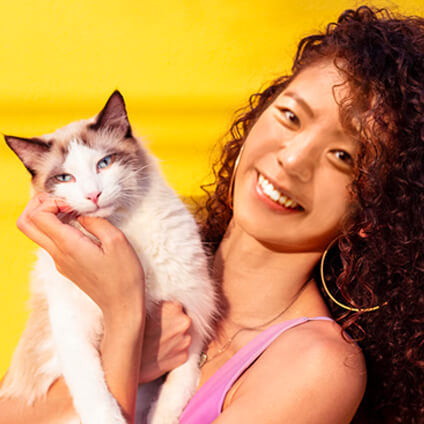
With over five years of specialized experience as an animal writer, my expertise lies in cat nutrition, health, behavior, grooming, and training. I am dedicated to delivering helpful and informative content that caters to the well-being of our feline friends. My primary goal is to empower pet owners with knowledge and ensure our feline companions thrive in health and happiness. In my free time, I love volunteering at local cat rescue centers.
